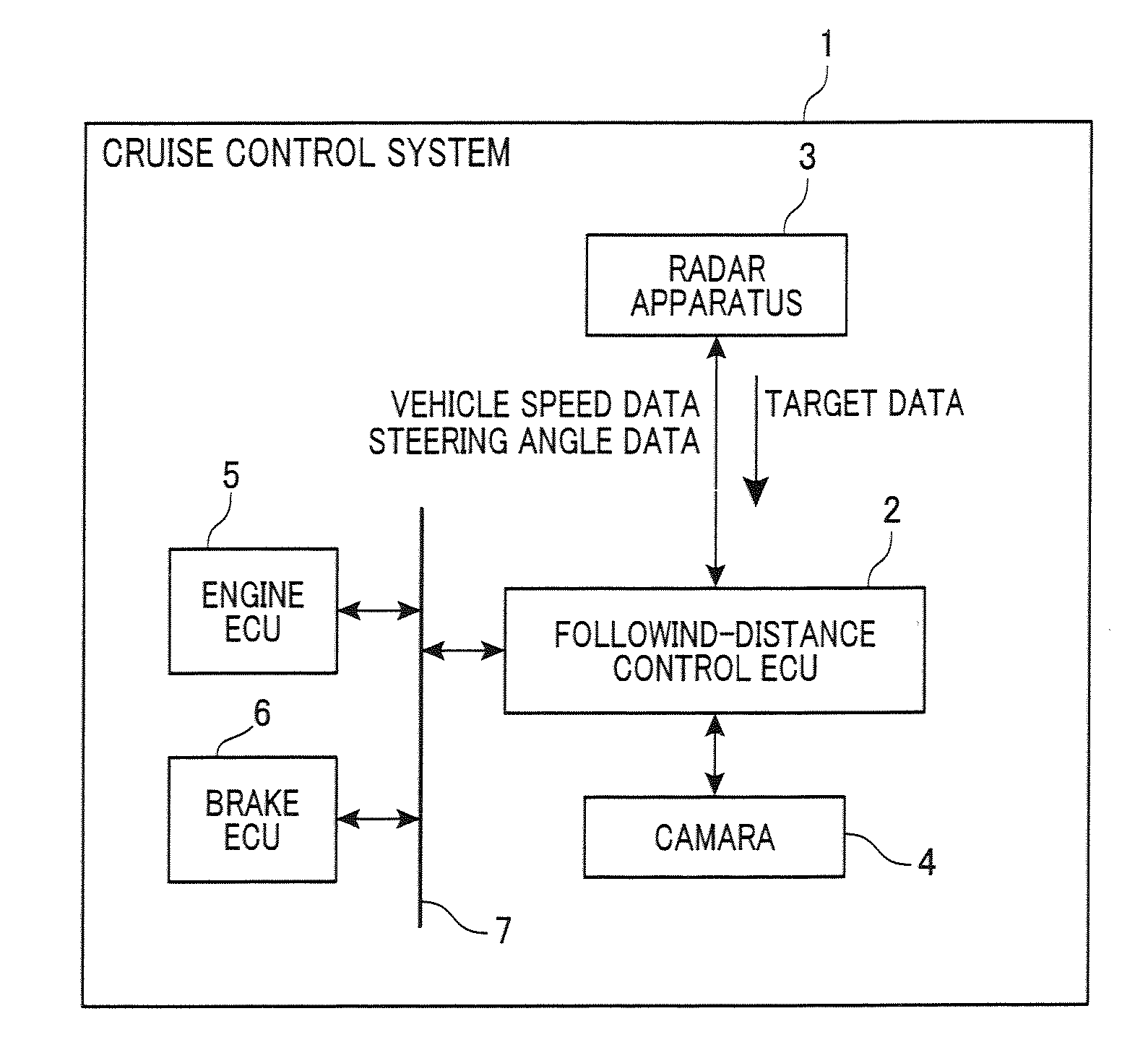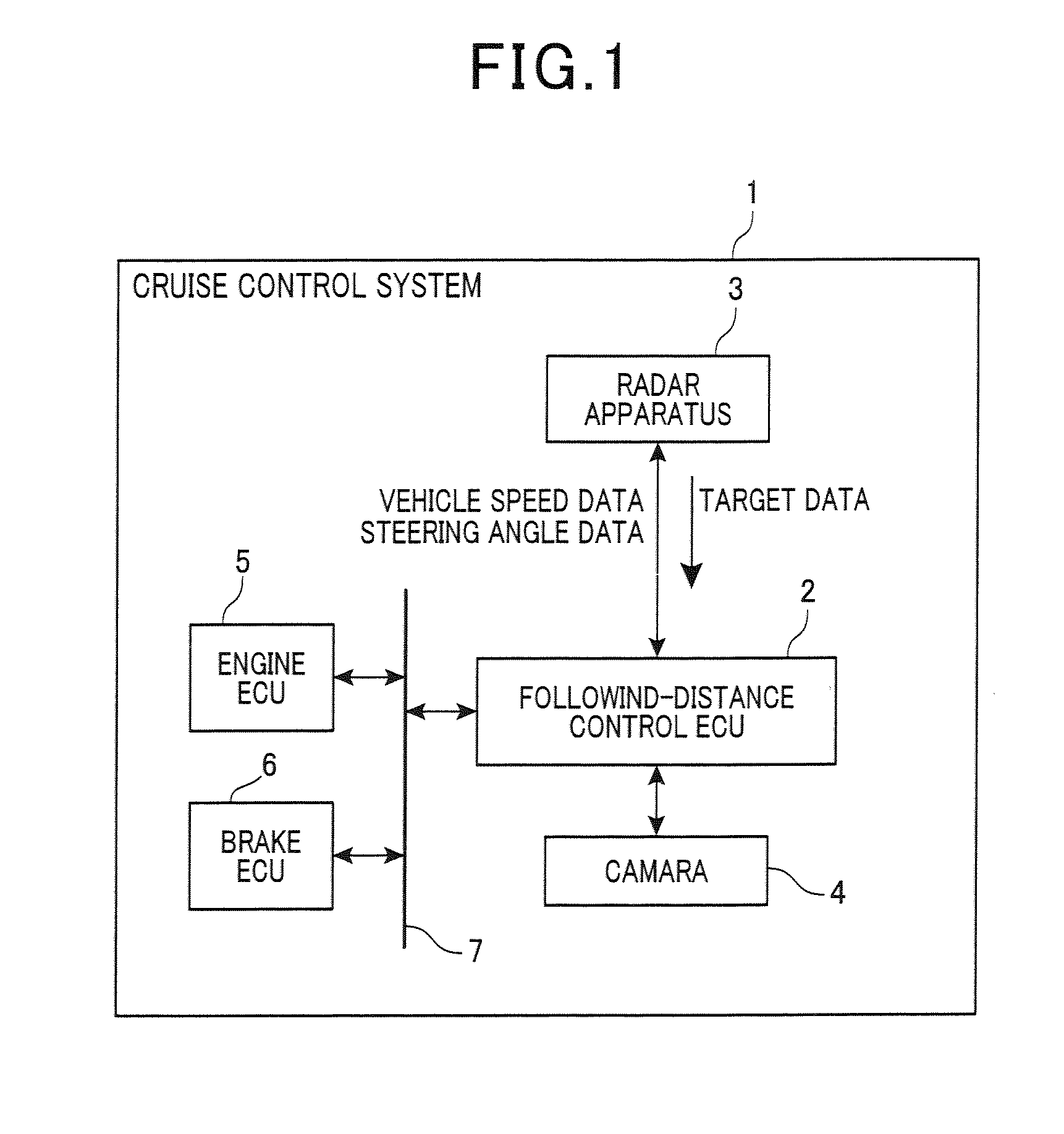Cruise control apparatus
a control apparatus and a technology for vehicles, applied in the direction of braking systems, process and machine control, instruments, etc., can solve the problems of reducing the accuracy of reducing the accuracy of the detection of the position of the front vehicle, and increasing the cost of operation
- Summary
- Abstract
- Description
- Claims
- Application Information
AI Technical Summary
Benefits of technology
Problems solved by technology
Method used
Image
Examples
first embodiment
[0021]FIG. 1 is a block diagram schematically showing the structure of a cruise control system 1 including a cruise control apparatus according to a first embodiment of the invention. This cruise control system 1 is mounted on a vehicle (may be referred to as the own vehicle hereinafter).
[0022]As shown in FIG. 1, the cruise control system 1 includes a following-distance control electronic control unit (referred to as the following-distance control ECU hereinafter) 2, a radar apparatus 3, a camera 4, an engine electronic control unit (referred to as the engine ECU hereinafter) 5, a brake electronic control unit (referred to as the brake ECU hereinafter) 6. The ECUs 2, 5 and 6 are connected to one another through an in-vehicle LAN 7 so that each of them can transmit and receive various data to and from the other ECUs.
[0023]The engine ECU 5 transmits, to the following-distance control unit ECU 2, data representing a vehicle speed, an engine control state and an accelerator operation st...
second embodiment
[0041]Next, a second embodiment of the invention is described with a focus on difference with the first embodiment.
[0042]The second embodiment is the same as the first embodiment except for that the target data transmitted from the radar apparatus 3 does not include the own-lane probability, and the cruise control process is modified.
[0043]The cruise control process performed by the cruise control system 1 according to the second embodiment is explained with reference to the flowchart of FIG. 3. The cruise control process performed in the second embodiment is the same as the cruise control process performed in the first embodiment except for that steps S80 and S90 are eliminated, and steps S85, 95 and 97 are added.
[0044]In the second embodiment, if the determination result in step S70 is affirmative, that is, if the recognized front vehicle is a large size vehicle, the lateral position of the front vehicle, that is the position of the front vehicle along the width direction of the o...
third embodiment
[0049]Next, a third embodiment of the invention is described with a focus on difference with the first embodiment.
[0050]The third embodiment is the same as the first embodiment except for that the cruise control process is modified.
The cruise control process performed by the cruise control system 1 according to the third embodiment is explained with reference to the flowchart of FIG. 4.
[0051]The cruise control process performed in the third embodiment is the same as the cruise control process performed in the first embodiment except for that steps S87 and S88 are added. In the third embodiment, after completion of step S80, the process proceeds to step S87 where it is determined whether or not the front vehicle selected in step S50 is the same as the vehicle selected as a preceding vehicle in step S110 previously performed. If the determination result in step S87 is negative, the process proceeds to step S100. On the other hand, if the determination result in step S87 is affirmative...
PUM
 Login to View More
Login to View More Abstract
Description
Claims
Application Information
 Login to View More
Login to View More - R&D
- Intellectual Property
- Life Sciences
- Materials
- Tech Scout
- Unparalleled Data Quality
- Higher Quality Content
- 60% Fewer Hallucinations
Browse by: Latest US Patents, China's latest patents, Technical Efficacy Thesaurus, Application Domain, Technology Topic, Popular Technical Reports.
© 2025 PatSnap. All rights reserved.Legal|Privacy policy|Modern Slavery Act Transparency Statement|Sitemap|About US| Contact US: help@patsnap.com



